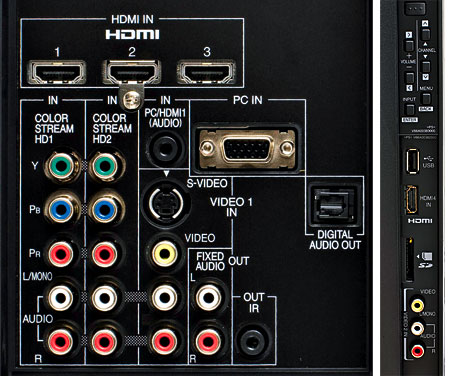Toshiba Regza 42ZV650U LCD HDTV
Price: $1,300 At A Glance: 240-Hz-like operation with 120-Hz refresh • Outstanding calibration adjustments • Sub-par contrast and black level
If any of the sets here offers a list of features that’s often lacking in far more expensive sets, it’s this one. The Toshiba includes full color temperature adjustments and Red-, Green-, and Blue-Only modes for properly adjusting the color and tint controls with a suitable test pattern. It also has a full (and I mean full) color management system and 240-hertz operation—sort of (more on this below). And this doesn’t even begin to address its slew of other features, some useful, others not so much.

Behind the Curtain
The Toshiba’s setup controls are far above the norm. Its color management system—in Toshiba-speak, ColorMaster—is one of the most complete we’ve seen. It offers Hue, Saturation, and Brightness controls for all six primary and secondary colors (red, green, blue, yellow, magenta, and cyan).
The Toshiba’s side and rear jack panels offer all of the usual suspects, including four HDMI ports and two component video inputs (which Toshiba calls ColorStream HD). You can play back photos, music, and movies stored on USB devices through the set’s USB port, or photos via its SD card slot—this was the only set that includes both options. It also has a PC connection, but it doesn’t have picture-in-picture, dual-picture capabilities, or an Ethernet (LAN) terminal for hookup to a home network.
The set has six preset Picture modes. I chose Movie for our tests, with appropriate adjustments. You can set up the video controls (including the Color Temperature and ColorMaster controls) separately for each picture mode and differently for the same picture mode when you’re using it on more than one input.
An oddly named Expert mode lets you turn on only the red, green, or blue portion of the signal. This is very useful for setting the Color and Tint controls in conjunction with a color bar pattern. It’s an accurate substitute for the imprecise color filters that some sets use for this purpose.
At a setting of –10, the Toshiba’s Static Gamma control produced a gamma of about 2.2 to 2.3 across most of the range, but it dropped to 2.85 in the darkest measurable region. (Gamma is the relation between the level of the input signal and the brightness of the displayed image. A higher number indicates a darker image. Expert opinions concerning the correct playback gamma range from 2.2 to 2.5, depending on your video guru du jour.)

Resolution+ is a feature that’s designed to help SD material look a bit more like HD. As far as we could see, it merely adds a trace of edge enhancement that serious videophiles will want to avoid.
DynaLight is said to improve the black level, and the separate Dynamic Contrast control offers adjustments from 0 to 10. As I noted in the introduction to this report, we didn’t use these features for the formal tests. But I did try them out. When used together, the two controls enhanced the Toshiba’s subjective black level and shadow detail, which added a little welcome punch on dark, difficult scenes. This might have made the Toshiba more competitive with the set that finished immediately above it. However, in the final analysis, my viewing suggested that this would not have changed its position at the finish line.
While other LCD manufacturers are providing 120-Hz operation in nearly all of their latest sets (the other three LCDs in this test have it), Toshiba has added 240-Hz operation, of sorts, by way of its ClearScan 240 feature. 240-Hz operation will cost you far more money elsewhere, since it’s now a flagship feature for many manufacturers’ top lines.
How did Toshiba put 240-Hz technology into a $1,300 set? By using a pseudo-240-Hz technique. The set has a native 120-Hz refresh rate, but this is supplemented by a scanning backlight that’s said to achieve some of the benefits of 240 Hz.
The Toshiba can accept 1080p/24 program material. With ClearScan 240 off and a 1080p/24 input, it repeats each real frame four additional times to reach the set’s 120-Hz refresh rate (5:5 pulldown). With ClearScan 240 on (and the Film Stabilization control on Smooth), some of the added frames are interpolated. In either case, the blinking of the scanning backlight creates the effect of two frames for each actual frame, approximating 240-Hz operation. With a 1080p/60 source (or any source that the set upconverts to its native 1080p resolution), a single frame (repeated or interpolated, as determined by the control settings above) is added for each real frame.
- Log in or register to post comments



































































